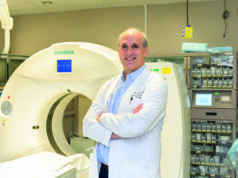
A randomised trial—AB-LATE02—will assess the efficacy of a combination of neoadjuvant atezolizumab, and adjuvant atezolizumab and bevacizumab with radiofrequency ablation (RFA) as a treatment option for patients with hepatocellular carcinoma (HCC). According to the principal investigator Boris Guiu (St-Eloi University Hospital, Montpellier, France), the treatment could improve recurrence-free survival (RFS) at two years, and may reduce the risk of distant recurrence, due to the synergistic effects of the treatment strategies. LATE02
Guiu outlined the rationale for the multicentre randomised trial, taking place in 16 centres across France, during a live “Meet the PI” session at the 2021 European Conference on Interventional Oncology (ECIO 2021, 10–13 April, online). During the session, Guiu was questioned by Philippe Pereira (Academic Hospital of Heilbronn, Ruprecht Karl University of Heidelberg, Germany) and Alban Denys (Lausanne University Hospital, Lausanne, Switzerland).
Ablation has become the first curative treatment for HCC, Guiu told attendees to the session, commenting that its use has increased steadily from 2013 to the present day. Discussing published data looking at RFA, however, he identified two problems. Firstly, the incidence of local recurrence, which occurs in between 5–20% of cases, and predominantly relates to the ability to obtain adequate margins around the tumour. “This is probably more of a technical than an oncological problem,” Guiu said.
Furthermore, he noted that intra-hepatic distant recurrence occurs very frequently—in around 60–80% of cases—and the debate is often whether its origin is a metastases or a de novo HCC. Guiu detailed the publication of a recent paper from his centre, which aimed to look at factors that may explain the presence of distant recurrence, including patient, disease, tumour and disease-related factors.
“We only found two factors associated with distant recurrence,” Guiu said, adding that these were alpha-fetoprotein (AFP) and tumour size. “In a way, these factors reflect the aggressiveness of the tumour and are more in line with the concept of metastases, at least during the first two years.” Further data show that de novo HCC are probably more frequent, Guiu noted.
In the case of a distant recurrence, there is a high risk that the patient cannot be treated using a curative approach, Guiu went on to add, meaning that the need to fight against metastatic escape and tumour growth becomes increasingly important. “There is a drift to palliative care, there is a drift to a palliative prognosis, and this is probably the key time where the patient is losing a good prognosis,” he commented. “We have to fight against this incidence of intra-hepatic distant recurrence and this a very important rationale to support the trial.”
A “new challenger” has recently entered the field of advanced HCC, Guiu said, the combination of atezolizumab and bevacizumab, which he commented show “synergistic effects”. The emergence of this treatment creates a strong rationale to combine immunotherapy and ablation, Guiu added.
AB-LATE02 will assess the treatment of small HCC (<3cm). In the standard arm, patients will be ablated using RFA, with follow-up carried out as normal. In the experimental arm, patients will undergo an induction with neoadjuvant atezolizumab, then ablation, and then treatment with the combination of atezolizumab and bevacizumab for one year.
The trial’s primary endpoint is RFS at two years, which Guiu said the study will aim to extend to 65%, compared to 45% seen in current literature. The study will enrol a total of 202 patients, who will be randomised 1:1 to either the experimental or standard treatment arm.
“What is important is that in addition to the primary endpoint we have to look to overall survival at five years, because we have the chance to change the game in these patients based on the results of this trial,” said Guiu.
The trial will also assess quality of life (QoL), which Guiu said will be important to consider, given the frequency of the treatment in the experimental arm. He explained: “We include QoL in this trial because it is very important to see if there is any impairment. In the experimental arm, we not only have ablation, but every three weeks the patient must go to the hospital to get immunotherapy, and this is something we need to look at and see if the balance, even if the trial might be positive, is positive for the patient.”
Finally, a comprehensive translational study is full part of the trial and notably includes immuno-monitoring, circulating tumour DNA (ctDNA) exome analysis, and peripheral blood mononuclear cell (PBMC) based on serial biological and tissue assessments.
At the time of the presentation, Guiu said that enrolment had already begun in three participating centres, and he anticipated that this would be the case in all 16 centres by the end of April 2021. Results are expected from 2025.










